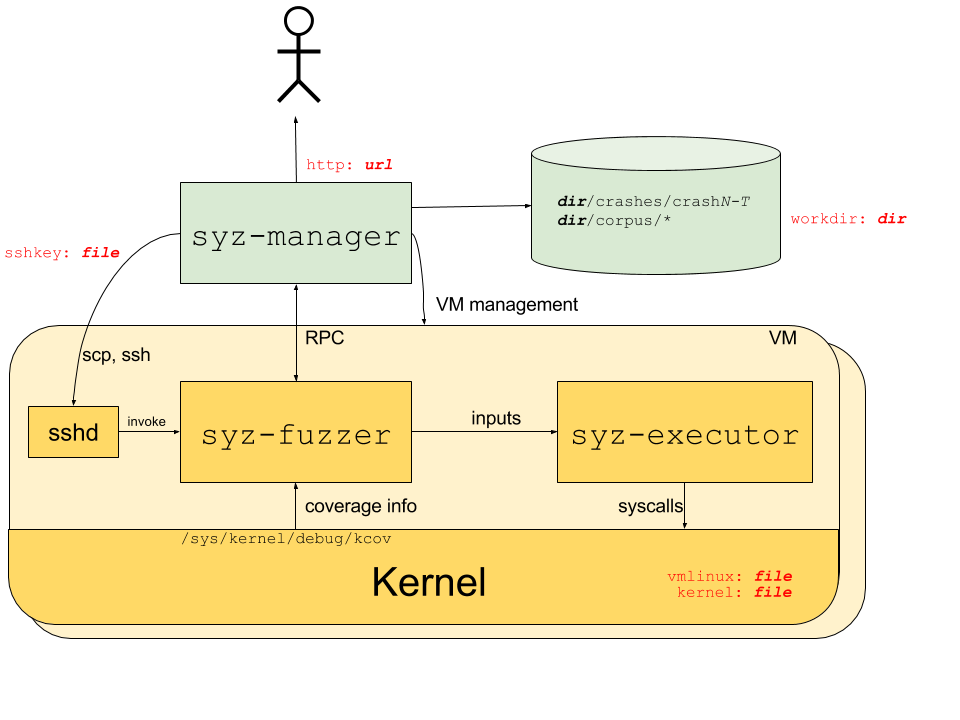Generic description of how syzkaller works are below.
Linux kernel specific internals can be found here.
The process structure for the syzkaller system is shown in the following diagram; red labels indicate corresponding configuration options.
syz-manager is responsible for:
- Starting/restarting/monitoring VM instances.
- The actual fuzzing process (input generation, mutation, minimization, etc.).
- Persistent corpus and crash storage.
It runs on a host with a stable kernel which does not experience white-noise fuzzer load.
syz-manager starts syz-fuzzer processes (one inside each VM).
syz-fuzzers comminucate with syz-manager over RPC to receive the programs
that must be executed and to report back the results (error statuses, collected coverage, etc.).
To execute programs, syz-fuzzer starts transient syz-executor processes.
Each syz-executor process executes a single input (a sequence of syscalls).
It accepts the program to execute from the syz-fuzzer process and sends results back.
It is designed to be as simple as possible (to not interfere with fuzzing process),
written in C++, compiled as static binary and uses shared memory for communication.
The syz-fuzzer process generates programs to be executed by syz-executor based on syscall descriptions described here.
Syzkaller is a coverage-guided fuzzer. The details about coverage collection can be found here.
When syzkaller finds a crasher, it saves information about it into workdir/crashes directory.
The directory contains one subdirectory per unique crash type.
Each subdirectory contains a description file with a unique string identifying the crash (intended for bug identification and deduplication);
and up to 100 logN and reportN files, one pair per test machine crash:
- crashes/
- 6e512290efa36515a7a27e53623304d20d1c3e
- description
- log0
- report0
- log1
- report1
...
- 77c578906abe311d06227b9dc3bffa4c52676f
- description
- log0
- report0
...
Descriptions are extracted using a set of regular expressions. This set may need to be extended if you are using a different kernel architecture, or are just seeing a previously unseen kernel error messages.
logN files contain raw syzkaller logs and include kernel console output as well as programs executed before the crash.
These logs can be fed to syz-repro tool for crash location and minimization,
or to syz-execprog tool for manual localization.
reportN files contain post-processed and symbolized kernel crash reports (e.g. a KASAN report).
Normally you need just 1 pair of these files (i.e. log0 and report0), because they all presumably describe the same kernel bug.
However, syzkaller saves up to 100 of them for the case when the crash is poorly reproducible, or if you just want to look at a set of crash reports to infer some similarities or differences.
There are 3 special types of crashes:
no output from test machine: the test machine produces no output whatsoeverlost connection to test machine: the ssh connection to the machine was unexpectedly closedtest machine is not executing programs: the machine looks alive, but no test programs were executed for long period of time
Most likely you won't see reportN files for these crashes (e.g. if there is no output from the test machine, there is nothing to put into report).
Sometimes these crashes indicate a bug in syzkaller itself (especially if you see a Go panic message in the logs).
However, frequently they mean a kernel lockup or something similarly bad (here are just a few examples of bugs found this way:
1,
2,
3).
